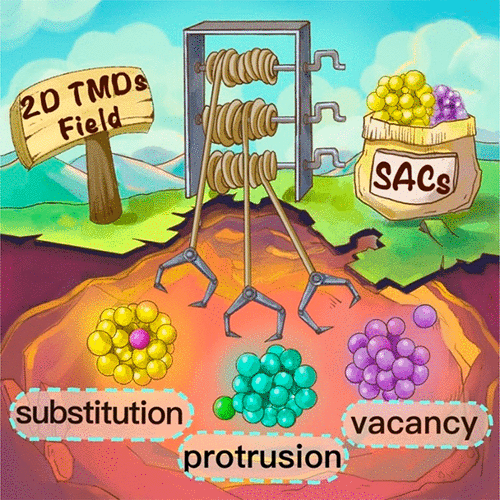当前位置:
X-MOL 学术
›
Chem. Rev.
›
论文详情
Our official English website, www.x-mol.net, welcomes your
feedback! (Note: you will need to create a separate account there.)
Single-Atom Engineering to Ignite 2D Transition Metal Dichalcogenide Based Catalysis: Fundamentals, Progress, and Beyond
Chemical Reviews ( IF 51.4 ) Pub Date : 2021-11-17 , DOI: 10.1021/acs.chemrev.1c00505 Xin Wang 1, 2 , Yuwei Zhang 1, 2 , Jing Wu 1, 2 , Zheng Zhang 1, 2 , Qingliang Liao 1, 2 , Zhuo Kang 1, 2 , Yue Zhang 1, 2
Chemical Reviews ( IF 51.4 ) Pub Date : 2021-11-17 , DOI: 10.1021/acs.chemrev.1c00505 Xin Wang 1, 2 , Yuwei Zhang 1, 2 , Jing Wu 1, 2 , Zheng Zhang 1, 2 , Qingliang Liao 1, 2 , Zhuo Kang 1, 2 , Yue Zhang 1, 2
Affiliation

|
Single-atom catalysis has been recognized as a pivotal milestone in the development history of heterogeneous catalysis by virtue of its superior catalytic performance, ultrahigh atomic utilization, and well-defined structure. Beyond single-atom protrusions, two more motifs of single-atom substitutions and single-atom vacancies along with synergistic single-atom motif assemblies have been progressively developed to enrich the single-atom family. On the other hand, besides traditional carbon material based substrates, a wide variety of 2D transitional metal dichalcogenides (TMDs) have been emerging as a promising platform for single-atom catalysis owing to their diverse elemental compositions, variable crystal structures, flexible electronic structures, and intrinsic activities toward many catalytic reactions. Such substantial expansion of both single-atom motifs and substrates provides an enriched toolbox to further optimize the geometric and electronic structures for pushing the performance limit. Concomitantly, higher requirements have been put forward for synthetic and characterization techniques with related technical bottlenecks being continuously conquered. Furthermore, this burgeoning single-atom catalyst (SAC) system has triggered serial scientific issues about their changeable single atom–2D substrate interaction, ambiguous synergistic effects of various atomic assemblies, as well as dynamic structure–performance correlations, all of which necessitate further clarification and comprehensive summary. In this context, this Review aims to summarize and critically discuss the single-atom engineering development in the whole field of 2D TMD based catalysis covering their evolution history, synthetic methodologies, characterization techniques, catalytic applications, and dynamic structure–performance correlations. In situ characterization techniques are highlighted regarding their critical roles in real-time detection of SAC reconstruction and reaction pathway evolution, thus shedding light on lifetime dynamic structure–performance correlations which lay a solid theoretical foundation for the whole catalytic field, especially for SACs.
中文翻译:

单原子工程点燃二维过渡金属二硫属化物催化:基础、进展及超越
单原子催化以其优异的催化性能、超高的原子利用率和明确的结构被公认为多相催化发展史上的一个关键里程碑。除了单原子突起之外,还逐步开发了另外两个单原子取代基序和单原子空位以及协同的单原子基序组件,以丰富单原子家族。另一方面,除了传统的碳材料基衬底外,各种二维过渡金属二硫化物(TMDs)由于其元素组成多样、晶体结构可变、电子结构灵活、和对许多催化反应的内在活性。单原子基序和底物的这种实质性扩展提供了一个丰富的工具箱,以进一步优化几何和电子结构以推动性能极限。与此同时,对合成和表征技术提出了更高的要求,相关技术瓶颈不断攻克。此外,这种新兴的单原子催化剂(SAC)系统引发了一系列科学问题,包括其可变的单原子-二维底物相互作用、各种原子组装的模糊协同效应以及动态结构-性能相关性,所有这些都需要进一步阐明和全面的总结。在这种情况下,本综述旨在总结和批判性地讨论二维 TMD 催化整个领域的单原子工程发展,包括其演变历史、合成方法、表征技术、催化应用和动态结构-性能相关性。强调了原位表征技术在实时检测 SAC 重建和反应途径演变中的关键作用,从而揭示了寿命动态结构-性能相关性,为整个催化领域,特别是 SACs 奠定了坚实的理论基础。
更新日期:2022-01-12
中文翻译:

单原子工程点燃二维过渡金属二硫属化物催化:基础、进展及超越
单原子催化以其优异的催化性能、超高的原子利用率和明确的结构被公认为多相催化发展史上的一个关键里程碑。除了单原子突起之外,还逐步开发了另外两个单原子取代基序和单原子空位以及协同的单原子基序组件,以丰富单原子家族。另一方面,除了传统的碳材料基衬底外,各种二维过渡金属二硫化物(TMDs)由于其元素组成多样、晶体结构可变、电子结构灵活、和对许多催化反应的内在活性。单原子基序和底物的这种实质性扩展提供了一个丰富的工具箱,以进一步优化几何和电子结构以推动性能极限。与此同时,对合成和表征技术提出了更高的要求,相关技术瓶颈不断攻克。此外,这种新兴的单原子催化剂(SAC)系统引发了一系列科学问题,包括其可变的单原子-二维底物相互作用、各种原子组装的模糊协同效应以及动态结构-性能相关性,所有这些都需要进一步阐明和全面的总结。在这种情况下,本综述旨在总结和批判性地讨论二维 TMD 催化整个领域的单原子工程发展,包括其演变历史、合成方法、表征技术、催化应用和动态结构-性能相关性。强调了原位表征技术在实时检测 SAC 重建和反应途径演变中的关键作用,从而揭示了寿命动态结构-性能相关性,为整个催化领域,特别是 SACs 奠定了坚实的理论基础。































 京公网安备 11010802027423号
京公网安备 11010802027423号